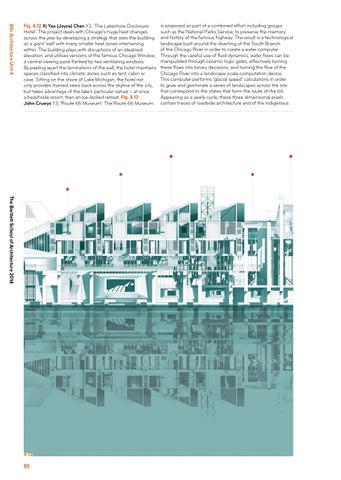BSc Architecture Unit 4
Fig. 4.12 Xi Yao (Joyce) Chen Y3, ‘The Lakeshore Disclosure Hotel’. The project deals with Chicago’s huge heat changes across the year by developing a strategy that sees the building as a giant ‘wall’ with many smaller heat zones intertwining within. The building plays with disruptions of an idealised elevation, and utilises versions of the famous Chicago Window, a central viewing pane flanked by two ventilating windows. By peeling apart the laminations of the wall, the hotel maintains spaces classified into climatic zones such as tent, cabin or cave. Sitting on the shore of Lake Michigan, the hotel not only provides framed views back across the skyline of the city, but takes advantage of the lake’s particular nature – at once a beachside resort, then an ice-locked retreat. Fig. 4.13 John Cruwys Y3, ‘Route 66 Museum’. The Route 66 Museum
The Bartlett School of Architecture 2014 4.12 86
is proposed as part of a combined effort including groups such as the National Parks Service, to preserve the memory and history of the famous highway. The result is a technological landscape built around the diverting of the South Branch of the Chicago River in order to create a water computer. Through the careful use of fluid dynamics, water flows can be manipulated through ceramic logic gates, effectively turning these flows into binary decisions, and turning the flow of the Chicago River into a landscape-scale computation device. This computer performs ‘glacial speed’ calculations in order to grow and germinate a series of landscapes across the site that correspond to the states that form the route of the 66. Appearing as a yearly cycle, these three dimensional pixels contain traces of roadside architecture and of the indigenous
